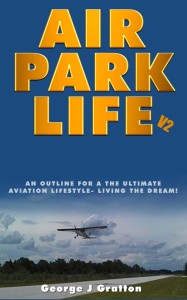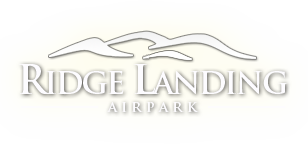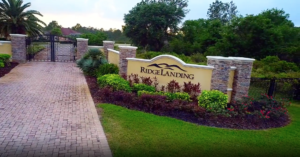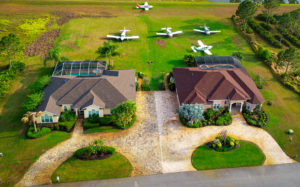A Pilot’s Guide to Landing in an Aviation Community
Definition: Airpark life is living in an aviators focused special-purpose community. It is living with a community of people in a unique place, all sharing an interest in aviation.
Airparks: Communities with development features designed to accommodate airplanes and aviators living with their home and aviation. This usually consists of real estate, runway(s), common areas, taxiways, in addition to the normal residential real estate considerations.
Disclaimer and disclosure: This forum is for informational purpose. I have specific and financial interest in 2 airpark properties and will make every consideration to be honest, unbiased, and impartial. I am a Florida licensed real estate sales associate. This document is advisory only, and should never be used as a substitute for proper professional counsel.[social-locker locker_id=”cba408c1f05d2829c” close=”false” message=”Share this page to unlock and download the Airpark Life eBook in Printable and PDF format!” facebook=”true” likeurl=”CURRENT” fbshare=”false” google=”true” googleurl=”CURRENT” tweet=”true” tweettext=”” tweeturl=”CURRENT” follow=”true” linkedin=”true” linkedinurl=”CURRENT”]Click the book or the link to download the Airpark Life eBook in PDF Format Airpark-Life-eBook [/social-locker]
[/social-locker]
Part 1 Why choose this aviation lifestyle?
The singular No. 1 reason to choose airpark life I hear over and over is:
A passion for flying! It’s an integral part of a persons life. This lifestyle brings this passion home. I have experience. The joy and convenience and solid value retention were great results from owning and living in an airpark.
Other reasons are also important. For example: Life with people of similar interest. Convenience and access to aviation. Highest quality neighbors of any community (Pilots are the best!). Quiet enjoyment of your home. Comfort of the security so inherent to aero-facilities. Economy of total lifestyle costs. Lets look at a few of these.
1) A passion for flying as an integral part of an aviation persons life. Pilots by nature and necessity invest a lot in being pilots. Whether a “young eagle” getting a 1st airplane ride, student pilot fresh from a 1st solo, to the retired ATP from years of international flights, it get’s in your blood, and provides a lasting joy. A “almost done” J3 Cub last flown decades ago lives in full harmony with airpark life, with its owner, a London bound captain in a 787 Dreamliner. Today and every day, aviators are aviators.’ Nuf said.
2) Life with people of similar interest. Just think about it. Few opportunities exist to move into a community with instant synergy and common interest. Not even Golf communities or Marina neighborhoods seem to have as close a bonding interest. Aviation people frequently reflect their aviation passion in other arenas as well.
3) Access to aviation. Just imagine, walk to your plane, fly from your driveway, park in your yard! It’s all part of the fun, and a business convenience too. A place to build the experimental plane of your choice at home. Load up baggage without loading and unloading the car . That’s a real “wow” factor!
4) Highest quality neighbors of any community (Pilots are the best!) Reality is aviation people are remarkable. Unusually smart, hard working people, and demographically lower crime risk than the general population. They frequently have very diverse experiences. They also necessarily have highly responsible lifestyle standards This is comforting at any stage of life, and especially valuable in protecting what and whom you value. This isn’t to be taken for granted. No security system ever made is better than no crime in the first place.
5) Quiet enjoyment of your home. This is a deed guarantee in most states that goes all the way back to the feudal system of the old world England. In the current allodial theory of real estate, a person may own land free of the overlord and with rights. A land owner may enjoy the possession and legal use of their property in peace and without the disturbance of other claims on the title by the seller or anyone else. This is a subtle advantage of an airpark. Property owners of non-aviation communities do not necessarily share our view on airplanes. That adds to the obvious physical quiet of the area. Airports take up room that reduces population densities, automatically reducing disturbances. To the best of my knowledge no air park has been close by neighbors complaints. The term frequently heard is a persons “home is his castle”
6) Security and comfort of the security so inherent to aero-facilities. Air parks are frequently patrolled, fenced and gated, located in low crime areas, off the beaten track of high vehicle traffic and low curb visibility. Again, no crime is still the best protection against crime. Airpark people know their neighbors, and what appears usual and what doesn’t. That’s good for your peace of mind, knowing your valuables (and loved ones) are safe and secure when you fly away.
7) Economy of total lifestyle costs. Housing cost is simply not the same as “lifestyle” expenses. If you add up the cost of housing, time and vehicle cost to commute to the airport, tax advantages, hangar rental, and miscellaneous expenses of redundancy, the overall lifestyle cost my be less than you think. An airpark will give you more “free” time, and provide a true economy of life style. Just the savings of those little “owner maintenance” item so easily done in your own hangar add up year after year.
Part 2 Location- Where are the airparks with hangar homes?
(Airpark Database Living with your plane)
Airparks are everywhere. I have visited or stayed at airparks from Peters Creek AK, British Columbia, Alberta, Iowa, NY, Arkansas, Georgia, and Florida. I have owned or leased in 3 different airpark locations. Airparks are all over the USA and Canada. Every one unique, with their own special charm. They are especially common in the SE USA, California, and Texas.
To find an Airpark, simply Google search “aviation communities” or check the real estate section of “Trade a Plane”.
Disclaimer and disclosure: This forum is not to specifically find, locate, or guide individuals to a specific location.. Information is generic based. Specific names are not included to avoid any conflict of interest and provide the most truthful information as I know it.
The old truism of real estate is LOCATION, LOCATION, and, LOCATION. It’s not much different in airparks. So let’s start with location.
The major consideration is: Will this location fit my life style? Selection for full time residency of a working person may be very different from a retiree. Future residency can be a decision as important to get right as much as any. “When” is also part of “where”. Do I need room for a private Boeing 757 or a LSA. The NBAA and The Flying Farmers are not going to necessarily share the same decision making.
Is it a good location for my family, a desirable destination for grandchildren. Is it urban or rural. Is it a party town? A sports town? A college town? All are variables for your consideration. Look at your neighbors home ,is it well kept, is it really airpark appropriate, does it meet the standards you require?
Step 1-As is the above. Determine where your preferences fit, what does not fit, what are needs, what are desires, and where is absolutely unacceptable. Write it down, review it, alter it as things change. Just do not ignore it. Then go to step 2.
Step 2 – Determine where is my value. Location cannot change. Look for valued locations. Examples of location values are proximity to employment, family, friends. How about climate? Access to major airlines, recreation, shopping, health care, education, and entertainment. Good answers can make your choice a desirable destination and added value. Destination areas, climates, and economics make destination valued property.
For aviation, Class B (big) airspace is a destination area indicator, but living in a Class B airspace can be very different than near Class B air space. Then go to step 3.
Step 3 Determine affordability. Why is this step 3 you ask? Elementary. Real estate is a big commitment. If step 1 and 2 are not satisfactory, no financial consideration need or should be done. Look at the whole picture for cost of living It is all about a life style, a passion, and a long term choice. You can build, fix anything, make new friends, but locations do not move.
Step 4 When looking at affordability, be thorough. DO NOT look only at the asking price. Look also to any HOA’s, property taxes, debt structure for common grounds, Community Development bond charges, special assessments, flood and property insurance, and services cost. Are gas and electric, drainage, water, sewers, phone lines, and cable available and/or accounted for. All are important for cost, most are common to any real estate. Don’t forget them just because it’s an airpark. I have found some pleasant surprises in some of these things. Some folks have had less favorable experiences. Do your home work BEFORE you close a deal.
Part 3 -Aviation Community Features & Functions
We looked at why and where, now in this section, we can look at what makes a good air park. Features an function are the next progression of the decision making.
Lets examine the first things first. That is: What are you buying? Is it a building lot, a home and hangar, or a home and community hangar, a cooperative, a condominium, a vacant lot, a private runway, or a “thru the fence” access to a muni airport. All are distinctive and different rules apply.
1) Cooperatives-In this case, the traditional ownership is a corporation. The residential owners actually have a share in the cooperative, a right to a lease of their residence, and a share in the common holdings. Different states have different corporate laws. Corporations have bylaws to follow. I would not recommend such without an attorney review. Caveat emptor. Be sure your rights are protected by the corporate by-law and deed.
2) Condominiums-You own your place in the development, and a share in common grounds. ,A common expression I hear is “you own everything inside the paint”. Similar to the co-ops, rules and bylaws are important,but condominium owners are usually the deeded owners. Flexibility of floor plans, expansions, and additions become difficult. in this arrangement. Sharing common walls, roof, driveways,etc., must be accounted for in writing. You want no surprises.
3) Zero lot line Condominiums-You have a mixture of Condominium with a a vacant lot or residence. You have everything inside the defined lot. It is like condominium, and the rules are usually nearly the same. You usually are fully and individually responsible for maintenance
4) Lease/rental- Lot or space rental is common in the camper and motor home trade. A natural progression from that was the temporary, seasonal, or full time airpark. These may be easy and price attractive. Be aware of potential value depreciation with time often associated with this type of living space structure. Also be aware of the more transient, and therefor less stable communities may mitigate some of airpark benefits. Some of these facilities have nice amenities, and a solid following. Some have adapted co-op and condominium business plans. The diversity here requires diligence in learning what is the community value.
Rental for a “test flight” for the life style can be an excellent per-purchase idea. I have actually done that with out any intention of real estate sales. None the less, ended up with 2 families buying in my home area. They liked it sooo much. You may wish to check with the developer or sales people in an area you are interested in. You may find a seasonal or temporary rental arrangement can be made.
5) Residential Real Estate and lot sales-This is the most familiar type of ownership. You own it, you pay the taxes on it, you maintain it, it is your castle. There are usually Home Owner Association (HOA”s) fees, rules, and restrictions. Common areas may be community owned, developer owned, municipal, or cooperative shared, and more Almost any airpark has this and /or some combination of these. This is frequently the most preferred route, and allows the most flexibility and custom home design.
Part 4: The Airpark Runway
Now let us look at the Runway. This is the big Aviation part of the equation. I will be just plain bold here, only consider a runway of more than 2200 ft as adequate (½ mile if obstructed on approach/departure) unless you are ABSOLUTELY sure that’s what you want. Yes I know can handle1600 ft, My plane needs 1000, but I can”t do that. That’s it. Your OK, but resale it can get challenging, because your market shrinks proportional to the runway . My rule of thumb is-add up the take-off distance and the landing distance, full loaded on a hot day, add 100 ft. That is my recommended minimums. Look at the the same numbers for the “hottest ship” reasonably expected to land there and add 30% for twins, everybody else should be OK too.
Paved and lighted is the gold standard for private facilities. Sod is fine if it’s high, dry, and firm. And yes there are lighted sod fields. My recommendation is ½ mile paved with clean approaches is a minimum for my Comanche.’Ya’all be careful, it’s a jungle out there. Again think of the resale value. Longer is better! An instrument approach is a “wow” factor.
Runways into the prevailing wind is better than crosswind. This can be a nice thing in NY, but absolutely vital in west Texas. Crossing runways are a luxury. More is better.
Thru the fence operations to public use facilities can offer some operating cost advantages. The AOPA and EAA successfully blocked Homeland Security attempt to eliminate these operations from Muni’s, public use runways, and the like. I personally recommend you better like the opportunity without the runway. So far so good. Again caveat emptor.
Taxi way and ramp space is also important. Co-mingling pedestrian, automobiles, and airplanes can be problematic. You cannot imagine the number of vehicles you run into that do not have any respect for aircraft right-of-way. Yes the plane is wide. No it won’t just back up into a driveway. Yes, your trash can is taller than my wings. Aviation people are not usually the problem. Nosy realtors, curious neighbors, service people, and pizza delivery are. A gated access is pretty standard today. Without it traffic problems only get worse. A gated community of aviation people and separate traffic is the gold standard here.
Some public use runways were built using federal funding in part or in total. Money given from the airport trust fund usually has strings attached. Common stipulations, including keeping it open, public use, and for a long time period are common. This can be both a comfort and a restriction. The usual penalty for non-compliance is monetary (returning the money). If federal money is involved, know what’s the current status and future plan.
Part 5 House, Hangar Home, and Pilot Living: This is about the actual physical property and and a lot more.
Amenities are also a value added. Everything from golf to equestrian centers can be found. Be sure if the amenities are there, who pays what for them. More is not always better. Look for what YOU will use in amenities. It is your life, your dream, and your nickel after all. Airplane services are nice too. Fuel availability can be discounted with fuel clubs. A friendly mechanic, groundskeeper, transient (community) hangar, storage facilities, and CFI are also really handy. An Aero-club can be very enjoyable and economical too. Commercial operations on the field however, can be a mixed experience.
HOA’s, love ’em or hate ’em are participants in your decisions. Look at them and ask: Are they self serving, or do they serve me and my neighbors? A good HOA will enforce rules fairly and consistently. They protect my property values and those of my neighbors. A really good HOA is a value added. Balanced, impartial, and effective rules are your friend, especially when disputes come up. Also check for the financial history of the overall property, it’s debt, bankruptcy, tax liens, special assessments, etc. It isn’t just your individual deed, it is the whole community health and condition.
The house is where you will spend most of your time. Make sure it fits your life. The smallest is the camper-trailer community. They have a solid following, usually no hangar, usually seasonal housing. They offer a very reasonable cost option and may fit you just fine. Take note, the HOA is really important!
A bachelor with 800 sq. ft. home and 4200 sq. ft. hangar has lots of room for his toys, but little interest in resale appeal. A beautiful 8000 sq. ft. house in a trailer community can be the least expensive way to build, but least value. Just a few advise codicils. Your house should fit the neighborhood. I recommend 1600 + sq. ft. living area, 2 ½ bedroom, 1 ½ bath minimum for resale value. The hangar should be about the size of the house or smaller. The typical 2000 to 3500 sq. ft. living, 3 to 4 bedroom, 2 bath, 2 car garage, 1200 to 1500 sq. ft. hangar will fit almost any potential buyer’s needs, and be neighbor friendly. Variations of as much as 20% are not too uncommon. Wisdom is be equally cautious of over improvement as under developed. Functional obsolescence is fixable in many cases. The biggest and best for a location may be the best price for that home. Your money, Your life, Your choice! A down side of any real estate holding is liquidity. This can be mitigated to a degree by careful consideration to the home specification and location.
Hangar and hangar doors also are unique to the life style. A tie down will suffice, but not add much value. Hangar protection for your plane is important. Protection from ice/snow in the north, sun in the south, and extremes of weather anywhere is the name of the game. A decent minimum is 28 x40 hangar, with 38 x9 clear open door. Bigger is better. I recommend 42 x 30 with a 12 foot door should provide a usable 40+ x29+x 9+ clear area. As such an 11 foot inside ceiling is an adequate one plane minimum. That can be T shaped if a loss of storage space is not important, and add living space to an attached house. Beware, it will probably not reduce building cost. Metal building structure is very popular and cost effective.
They offer full utility, and if done correctly, be very sturdy. Unfortunately, they can have some negative issues. Plane (plain?) boxes can be unattractive, rust, and may not offer the added value you need for resale in the future. They are also subject to HOA restrictions in many residential areas. Newer designs with attractive stone or brick facade can really be quite attractive. I don’t recommend Quonset corrugated metal type. Sturdy, cheap, durable and weather worthy, they just don’t look right in a residential community. They are usually found on farm strips, frequently doing double duty as equipment storage.
Doors are a whole subject alone. Sliding doors are low cost, and a favorite of large commercial operations. They are also easily jammed with ice, snow, mud, and airplane parts! They are also equipped with trip hazards, pinch points and broken bones (trust me, I do have painful memories of real experiences). Agricultural swing doors are a variation of sliders. They require no tracks, but need a hard surface to roll on.
Wind loading is also an issue. The electric bi-fold is the accepted standard. Be aware of size. Door size is NOT the same as clear opening area. To get 38 ft by 8 ft clear opening you may need a 40 x 10 door. That is my recommended minimum. 45 x 14 clear opening can hangar most of general aviation. A GAIN, bigger is better. Common sense should prevail. For example, I wouldn’t build for a Lear on a ½ mile sod strip. Many door manufactures make good products and are happy to help with engineering.
Part 6 Conclusions, Cautions, and Consummating The Deal
Real estate has been and will always be a viable product and valued asset. It can also be a source of pleasure, security, and a value to life style beyond the basic utility. It can also be complicated experience with risks and rewards. Let us look at some of those things.
What is this stuff about homesteading? Many states, not just Oklahoma, have or had some form of homesteading. This was a process of related but separate conditions that are implemented at the state level to encourage the real estate ownership in that state. Common misconception is it is to lower your taxes. It may in deed do that, but there is more to it. A tax exemption to the real estate owner (of variable amounts), of limited size of property, and and statutory conditions to protect spouses and family descendants are part of homestead process. Knowing the homesteading law in your proposed state for purchase is very important. This should be discussed and planned before closing to assure you get the full advantages of the system. A real estate familiar counsel is a great start.
Buying and selling to or from alien owners is also subject to some special rules. That is the real estate transaction for real estate in the United States to or from foreign entities.
I will not comment on the laws of alien ownership of property by any other country. I have some experience, but I am no expert of any kind. There is some United States rules you should know, regarding purchase of real estate from a foreign source.
The IRS require 10% of the gross sale price be withheld and paid to the IRS. This is to prevent the foreign sellers from avoiding the taxes due from the sale of real estate. Please, if you are closing a purchase with a foreign seller, consult with the IRS or an IRS tax specialist. Again good counsel at closing should be a big help.
Domestic selling has some cautions too. Capital gain tax, tax exclusions, and the various formulas used to determine eligibility are complex. A basic overview is the seller is allowed to be exempt from capital gains up to a certain amount, depending on single or joint return status, every 2 years.
This is to protect the sellers from an onerous tax burden when selling their residence, and provide the government adequate taxation on capital gains realized from “quick flips” and from other events that the government has the right to collect taxes. The usual occupancy rule for residence is 2 years of the last 5 years. Early professional tax counsel is wise.
So let’s consummate the deal! Wilkomen, bienvenue, welcome!- to the best real estate opportunities in an aviators heart.
International buyers and sellers are finding the USA a very friendly market opportunity. Values are good and low mortgage rates can still be found. Beware, time fly’s too.
License requirements for our FAA are compatible with most of the industrialized world nations. The FAA .gov website and the AOPA have information, but the best way is try to find someone who has done it recently. English language is used internationally, and terminology is similar. I did it many years ago in the UK and was a good experience.
So go ahead, dream -the dream, do the do, live this wonderful lifestyle. I have lived and loved this lifestyle for decades.. My property values went up, costs acceptable, and joy terrific. The downsides are few. The key to success is: Know what your doing. You will have a very good experience too. Use a checklist just like when you’re flying, and you will have happy landings.
Airport Homes Q and A) There was a live Q&A at the forum, for further information please email George email GGRATTON@GMAIL.COM







